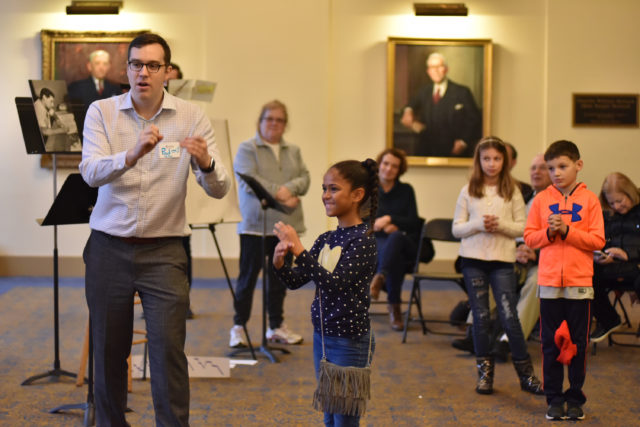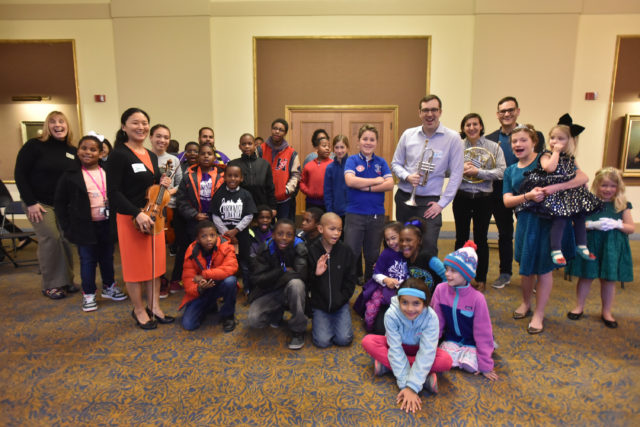Allegro
Reaching out to the next generation
Reflections of a New York Philharmonic teaching artist
Volume 119, No. 8September, 2019

Local 802 member Paul Murphy with children in Ann Arbor (pictured above and below), on a tour with the New York Philharmonic. Teaching artists have the chance to convey the joy of live music to the next generation. (photos by Peter Smith)
What’s it really like to work as a teaching artist? Allegro recently got a chance to listen to trumpeter Paul Murphy, a member of Local 802 since 2008, to get his insights. Members of Local 802 who work as teaching artists can e-mail Allegro@Local802afm.org to share their own experiences or insights.
Allegro: You’ve been working as a teaching artist at the New York Philharmonic and with other institutions in the city for over a decade. Can you describe what it means to be teaching artist?
Paul Murphy: Being a teaching artist is like being a tour guide. A great tour guide doesn’t hit you over the head with facts and information about your journey, but instead focuses on facilitating your experience. Some stretches of your journey might be enhanced by a tour guide joining alongside you as a co-adventurer. Still other stretches may be best experienced alone, and a wise tour guide might recede into the background to better enable you to make your own discoveries. No two journeys will be exactly alike – there is an art to getting it right. As a musical teaching artist, my job is to help others discover their own meaningful connections to music. There are times when I’m able to share a musical performance with my audience that connects without any help from me – perhaps that’s ideal. But there are times when I find it helpful to draw on an additional skill set that goes beyond my musical chops as a trumpet player. I speak well from the stage. I know how to design interactive activities for audiences. I’ve invested an extensive amount of time and care into my work as an educator. I’ve learned to read an audience and have developed instincts about creative ways to respond to varying situations. These are some of the many skills teaching artists use to help draw others more deeply into the art of music. The skills used by teaching artists aren’t necessarily new to musicians, even if the term “teaching artist” didn’t come into wider usage until the 1970’s, among a team of interdisciplinary artists working together at Lincoln Center Education. I’m sure that many of my fellow Local 802 musicians have been engaged in doing this type of work for years – even if they don’t necessarily identify with the term. “Teaching artist” may serve as useful language in that it helps to give a name – and value – to this additional skill set. These skills are increasingly in demand by many cultural institutions, presenters, and the performing arts marketplace.
Allegro: Can you tell us a little more about your role as a teaching artist at the New York Philharmonic? How long have you been working for the orchestra, and what does your job entail?
Paul Murphy: While I’ve worked as a teaching artist for many organizations, I’ve been particularly fortunate to serve as a member of the teaching artist faculty at the New York Philharmonic for the past 11 years. I think some people might be surprised to learn that the orchestra maintains a faculty of around two dozen teaching artists on staff. We’re a highly collaborative and creative bunch of people – it’s been a privilege to work with such fantastic colleagues at such a storied institution! My role with the orchestra is part-time. I typically spend around 60 days a year in classrooms throughout the city. Last semester, I was reflecting with my students about their recent field trip to the New York Philharmonic. They had just experienced this year’s Young People’s Concert for Schools: “Coming to New York – Immigrant Voices.” The program featured the music of Béla Bartók as well as living composers Gabriela Lena Frank, Huang Ro, Kareem Roustom, Roberto Sierra, and several participants in the NY Philharmonic’s Very Young Composers program – who are the same age as my students. One of my teaching artist colleagues, Jihea Hong-Park, served as the concert host and was able to share her own poignant story about coming to New York City. I had been preparing my students for the concert for much of the school year, and have been looking forward to hearing them reflect on their experience with the orchestra. I love observing the many different ways in which students connect with music – I think we adults rarely give them enough credit for how perceptive they can be. A group of my third graders discussed their awe in hearing the powerful sound of a live symphony orchestra for the first time – they asked me why the music sounds so different when they experienced it in person at the hall compared to when they’ve heard it on my portable Bose speaker. Another group of students was fascinated by how cultural identity can be expressed through music – and they’re now working to compose music that celebrates their own cultural identity as part of a final project. Several fifth grade girls wasted little time in telling me how important it was to them to hear the orchestra play music by women composers. They challenged me to ask the New York Philharmonic to create more such music – and I promised these young women that we will. In my students’ conversations I hear a space where the orchestra is alive and resonating. As they are every year, my students were especially amazed that the orchestra performed music composed by students their age – something made possible by the Very Young Composers program. The program was started by former associate principal bassist, composer, and teaching artist Jon Deak, and has grown tremendously in recent years. It certainly wouldn’t be possible without the dedication of my teaching artist colleagues who possess the skills to help young composers discover their own compositional voices. While the majority of my time at the Philharmonic is spent inside the classroom, teaching artists are tapped for our expertise in other areas as well. We are frequently asked to help design and perform in interactive concerts for our students, and may often lead educational workshops for classroom teachers and music educators. Teaching artists may also be asked to write curricular materials for the orchestra, and on occasion have even hosted the Young People’s Concerts.
Several fifth grade girls wasted little time in telling me how important it was to them to hear the orchestra play music by women composers. They challenged me to ask the New York Philharmonic to create more such music
Allegro: A significant portion of your career has been working as a freelance musician under union contracts, like Broadway, Orpheus, Radio City, St. Luke’s, and more. How does your work as a teaching artist intersect with your work as a performing musician?
Paul Murphy: Performing and teaching are not the same – each requires a distinctive set of skills – but they are also not unrelated. I happen to have a genuine love for both. Drawing others more deeply into music has always been the unifying force that motivates me, whether I’m performing onstage at Carnegie Hall, or working with my fifth grade students in the classroom. Of course, the rules of how to succeed when playing as a member of an orchestra are vastly different than the rules of how to succeed when working with a classroom full of fifth graders. Knowing my role, and how to navigate the rules for any given situation can sometimes be tricky as I wear so many different hats. However, I’ve noticed that there are benefits to switching back and forth between teaching and performing – each strengthens the other.
Allegro: It seems like teaching artists are becoming increasingly visible in the arts scene. What does the future hold? What issues do teaching artists face? How do you suggest musicians get more involved in this type of work?
Paul Murphy: Cultural institutions around the city – including Carnegie Hall, the New York Philharmonic, Jazz at Lincoln Center, and many smaller arts organizations – are increasingly relying on the creativity and skills of trained teaching artists to provide high-level education and community engagement programs. There are currently thousands of teaching artists working across New York City in music, dance, drama, visual arts, multimedia, and every other discipline that you can imagine – all working to bring audiences into meaningful experiences with art. It’s a scene that has grown up a lot in the past few decades, even if it’s still relatively new and sometimes hard to define precisely. The work inherently calls for responsiveness and creativity. I see a bright future ahead for teaching artists. At the same time, as the field of teaching artistry expands, it will need to get better at addressing issues of sustainability. Wage transparency, working conditions, health care, and retirement are – perhaps not surprisingly – all issues that could be better discussed and addressed within the field. Rates of pay can vary wildly from organization to organization. Burnout is not uncommon. The teaching artist community is beginning to have these important conversations. For musicians who are curious about becoming more engaged in this scene, I might suggest reading “The Music Teaching Artist’s Bible: Becoming a Virtuoso Educator” by Eric Booth. This is a great way to get a broad overview of what it means to be a teaching artist. I would also highly recommend “Engaging the Concert Audience: A Musician’s Guide to Interactive Performance” by David Wallace. This book contains valuable information for anyone looking to improve the connection between your audience members and your performance. Lincoln Center Education offers teaching artist training through its Teaching Artist Lab, which takes place annually during the summer. Its 10-day training sessions are designed for teaching artists of all levels and disciplines who work in education and community settings. Teachers College recently developed a yearlong certificate program in responsive pedagogy for established teaching artists looking to expand their pedagogical strategies in school and community settings. Another space to learn more about the teaching artist community is through the annual Face to Face conference put on by the Arts in Education Roundtable. They also host events and workshops for teaching artists throughout the year. It’s also worth mentioning that some institutions that employ teaching artists provide paid on the job training and professional development – the Philharmonic is one such institution. For those who are interested, teaching artist auditions are held each spring.

